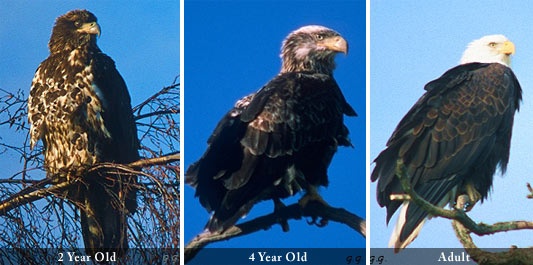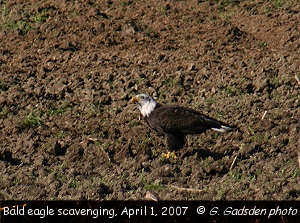The Bald Eagle
By Gord Gadsden
April 2007
Bald eagles are B.C.'s largest raptor. Their wingspan is around 2 metres (6 to nearly 7 feet) from  wing tip to wing tip. Like most raptors, females are larger than males weighing between 2.5 kg (5.5 lbs) for males to 5.9 kg (13 lbs) for females. Male and female bald eagle's colouration is the same. Bald eagles are true to the saying 'eagle eyes' having very acute vision; 6-7 times better than a human's. Their main food sources are fish and carrion, but they will also catch and eat small mammals, waterfowl and seabirds. A bald eagle's lifespan can exceed 30 years of age. wing tip to wing tip. Like most raptors, females are larger than males weighing between 2.5 kg (5.5 lbs) for males to 5.9 kg (13 lbs) for females. Male and female bald eagle's colouration is the same. Bald eagles are true to the saying 'eagle eyes' having very acute vision; 6-7 times better than a human's. Their main food sources are fish and carrion, but they will also catch and eat small mammals, waterfowl and seabirds. A bald eagle's lifespan can exceed 30 years of age.
Identification
It takes about five years for a bald eagle to obtain its trademark white head and tail feathers. When they leave the nest, they are almost completely brown with variable amounts of white scattered throughout the breast, underwing and tail. This white colouring will often increase through their second and third years until they start to get the first hint of dark body with white heads and tails by four years of age. Understandably, juvenile bald eagles are often mistaken for golden eagles who are uncommon on the coast.

Breeding
Bald eagles build nests in tall trees near water. The nest, about 1 metre (2.5 feet) deep and 1.5 metres (5 feet) wide, is built with large branches lined with twigs, grasses and feathers. The same nest is used year after year with the adults adding new nesting material each year before the laying of eggs. Some nests are used for over 35 years and not necessarily by the same eagle pair. After many years of use, a bald eagle nest can grow to be over 3.5 metres (10 feet) wide and weigh several tonnes. At this point the tree which supports the huge nest will often break or fall down. If this happens, the eagle pair will usually start a new nest nearby. Female bald eagles lay 1 to 3 white coloured eggs which will hatch in about 35 days. Hunting, feeding, incubation and nest defense are shared between the male and female. Bald eagle eaglets can fly after about 12 weeks from hatching. A bald eagle pair mates for life but will find a new mate if one dies.
Bald Eagles in the Fraser Valley
After the breeding season ends in late July or early August, the Lower Mainland bald eagle population  migrates north for a few months. They then return in late September or October. Thousands of additional northern birds will also come south at this time, their numbers usually peaking in early December. The eagles will congregate on local rivers and other nearby salmon spawning streams to gorge on the decaying salmon carcasses. They can also often be found in agriculture fields, usually later in the winter, when salmon carcasses are completely devoured or swept away by high water events. Large numbers of waterfowl and carrion found in chicken manure is the attraction for these areas. These wintering eagles will feed in the Lower Mainland until the eagle nesting season starts over in mid-February. At this time, the northern breeders will then leave for their nesting areas. Over 250 pairs of eagles nest in the lower Fraser Valley and these birds will remain in the area to raise young. migrates north for a few months. They then return in late September or October. Thousands of additional northern birds will also come south at this time, their numbers usually peaking in early December. The eagles will congregate on local rivers and other nearby salmon spawning streams to gorge on the decaying salmon carcasses. They can also often be found in agriculture fields, usually later in the winter, when salmon carcasses are completely devoured or swept away by high water events. Large numbers of waterfowl and carrion found in chicken manure is the attraction for these areas. These wintering eagles will feed in the Lower Mainland until the eagle nesting season starts over in mid-February. At this time, the northern breeders will then leave for their nesting areas. Over 250 pairs of eagles nest in the lower Fraser Valley and these birds will remain in the area to raise young.
|